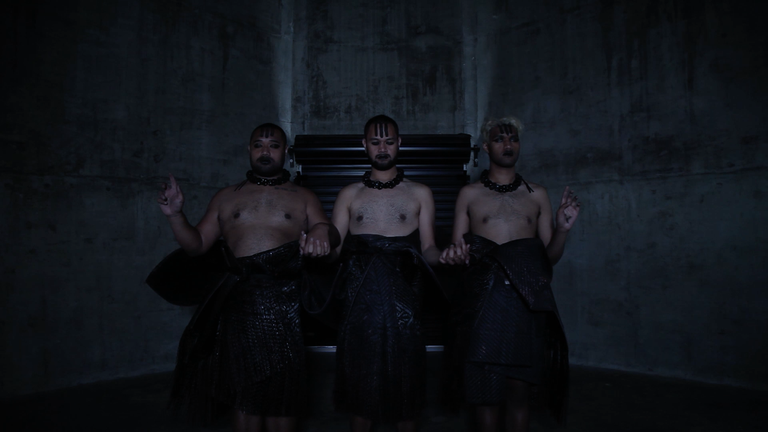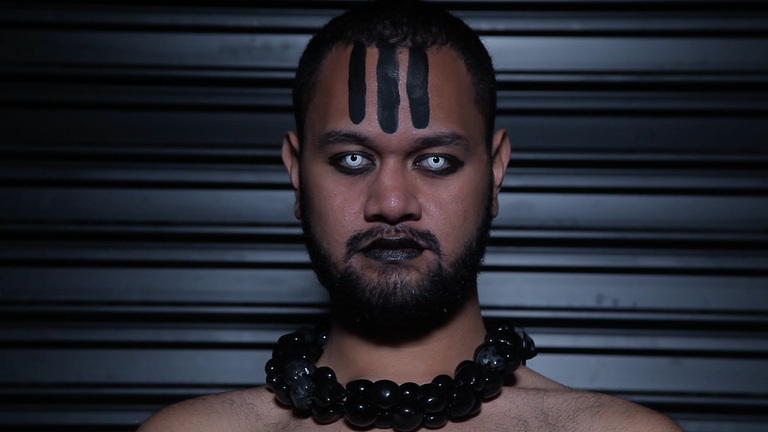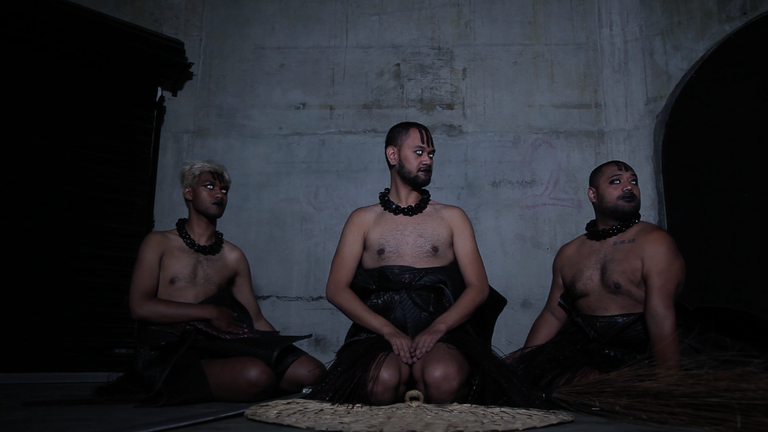Exhibition Essays
WITCH BITCH presents Statuesque Anarchy
March 2017
Eyes closed, eyelids painted black
Dilohana Lekamge
Vā is the space between, the between-ness not empty-space, not space that separates but space that relates, that holds separate entities and things together in the Unity-that-is-All, the space this is context, giving meaning to things
Albert Wendt, 1996
The collective WITCH BITCH—made up of the artists Manu Vaea, Sione Monu and Pati Solomona Tyrell— is an extension of the prolific Auckland-based collective FAFSWAG; an interdisciplinary group of artists and performers whose following is rapidly growing both within New Zealand and overseas. FAF SWAG are predominantly known for hosting the FAFSWAG Ball, a riotous event modelled after the vogue ball scene that originated in the United States and became popular in gay underground culture in the 1980s.1 Balls were and still are an opportunity for outlandish and unfiltered expression for the queer community, where participants and attendees are able to present as they please.
Though there was a lively display of voguing and a sneak peak into what may be seen at a vogue ball during the performance showcase accompanying Statuesque Anarchy, the focus of this exhibition at Enjoy in March 2017 was not so light-hearted. The members of WITCH BITCH presented a combination of video, performance and sculptural costumes that hauntingly harked back to precolonial South Pacific culture and created further opportunities for other Polynesian people in New Zealand to explore their ancestral spirituality, gender and sexuality. In Statuesque Anarchy, WITCH BITCH reignited connections with their roots before the occurrence of colonisation and migration through the activation of space—activating the vā between themselves, their ancestry and Aitu;2 and activating the physical exhibition space through video, installation and live performance.
In many historical records from explorers and missionaries alike, it is documented that prior to colonisation, gender and sexuality in Polynesian cultures did not exist in the form of the heteronormative binary that we are so familiar with now in our Euro-centric worldview. Accounts of gender liminality were scarcely mentioned in coloniser’s accounts of interactions with Polynesia since people such as fa’fafine and fakaleiti did not fit within the rigid construction of gender that Europeans had established. Religions such as Christianity and Catholicism infiltrated Polynesia and introduced the idea of one all-powerful overseeing deity, who instructed his followers not to praise any other God, otherwise, they would be subject to eternal damnation. Sexual expression that did not fall within the barriers of heterosexuality or heteronormativity would also result in the same consequence, with sexual acts that were non-heterosexual described by colonisers as ‘unnatural practices’.3 Despite this lack of recognition, in Polynesian cultures fa’fafine, fakaleiti and gender-liminal people have long been valued members of their communities and often occupy roles usually filled by both men and women beneficial to their communities in various ways. Through their work, WITCH BITCH reclaim the cultural and personal value of their gender and sexuality.
In addition to the restructure of gender norms through Western religion and colonisation, diaspora has and continues to place the existence of indigenous culture and spiritual beliefs at risk. Western religion was also introduced to Aotearoa with the arrival of settlers and Christianity has prevailed as our most commonly practised religion. Through the physical separation from the South Pacific, the disconnect from Polynesian spirituality became greater as populations were physically separated from the homelands that initially harboured their indigenous sacred knowledge. In addition to this separation, gender liminal and non-heterosexual individuals were also exposed to the prevalent existence of homophobia and transphobia within the countries they immigrated to.
For Pacific peoples, degrees of detachment from their cultures continued into the 20th century, as racial intolerance towards Pacific Islanders greatly increased in New Zealand as the country saw huge influxes of Polynesian migrants from the 1950s onwards, even though it was many available jobs in the early 70s that introduced many workers from the Pacific Islands to New Zealand in order to fill these roles. Many migrants who came in this wave were on short-term working visas, but soon became seen as weights on our suddenly struggling economy. This sparked the infamous Dawn Raids as the Labour-led government at the time enforced regulations that allowed law enforcement to scour homes, usually at dawn, for migrants who they believed had over-stayed on their work permits. In addition to these raids, police would take people off streets, in very public situations, who they believed were also over-stayers. Often this was solely based on visual racial signifiers. This government-backed behaviour sparked even greater racial intolerance in New Zealand towards Pacific Islanders that still lingers today.4 These circumstances perpetuate racial stereotypes that WITCH BITCH combat by embracing their cultures, referencing their pre-colonial counterparts and a time where Eurocentric racism and prejudice didn’t exist. Finding and channelling power from this time not only gives the artists the opportunity to learn about their heritage, but opens up a pathway for other Polynesian New Zealanders and Polynesians living in New Zealand to proudly explore culturally integral subjects with the knowledge that it is encouraged by their peers.
In response to the combination of colonisation, spiritual erasure and the separation from their homelands, WITCH BITCH crafted a belligerent protest by juxtaposing elements of Western filmic devices and traditional Samoan and Tongan culture—facilitating cross-cultural and supernatural experiences. The artists presented an activation of the exhibition space on the opening night that reflected the content of the video work, both of which haunted the attendees of the opening and exhibition.


Manu Vaea, Pati Solomona Tyrell, Sione Monu, WITCH BITCH presents Statuesque Anarchy, 2017. Three-channel digital video, single channel video stills. Images may not be reproduced without permission from the artists.
Presented over three monitors, the central three-channel video began with an image of the artists standing in line, holding hands in a row with Vaea in the centre, and Tyrell and Monu on either end with their outermost hand raised up and their index fingers extended. Their matching ta’ovala and an affronting linked stance introduced the artists as a collective and synchronised entity. Then all screens came alive at once, each showing a portrait shot of the individual artists. The artists were depicted with their eyes closed, eyelids painted black and all donning the same black facial markings of three lines painted from the centre of the hairline to the middle of the forehead. Monu, whose image was in the centre, began a series of three monologues while opening his eyes and revealing stark white eye contacts worn by each member of the trio, an unnatural eye colour that made them seem inhuman. All channels soon cut to Monu walking in his ta’ovala, an ominous monologue accompanying his movements through an empty urban concrete space. Monu was followed by Tyrell and then Vaea. Each monologue began and ended with the portrait shot of each artist opening their contact-covered eyes. In hand they wielded objects; Vaea a sapelu (machete), Tyrell a salu (broom) and Monu an ili (fan), all of which are everyday household items within Tongan and Samoan cultures. The versions used here were monumentally sized, giving each item more gravitas than their ordinary counterparts. These items were used as props for the individual artists in the work, embellishing their movements and actions.
During the exhibition, the sapelu, salu and ili that were used in the video work hung on the longest wall in the gallery and beneath them lay each artist’s ta’ovala, all left behind from the activation of Enjoy’s exhibition space on opening night. Walking into the gallery entrance during the opening, most viewers had to be prompted by other audience members to turn around to view the artists posing, wielding over-sized props on the stairs behind them. The audience was tightly packed into the room, becoming even more condensed as the artists descended down the stairs into the crowd to activate the space. The artists entered, introducing their bodies to the room with a commanding aura that was equally hypnotising and terrifying. They glided through the space, slowly dragging their feet and parting the crowd with the combination of striking stares and the movement of their large props. Soon after they entered the room, each artist began to chant their memorised monologues, as spoken in the video—mentioning and calling upon their ancestry, deities, spirituality and the harm that the Western world brought upon all those things. From as early as the preparation for the activation, the artists brought the vā between themselves and their ancestral past, the weight of which could be felt throughout the performance and the moments that the crowd lingered in afterwards. The occupation of space was otherworldly—haunting in a way that I had not previously experienced during an exhibition opening.
Similarly to the performance, the use of cinematic devices synonymous with horror and thriller movies were employed throughout the video to create a sinister exhibition of rebellion. Manipulation of natural eye colour and movement, for instance, have regularly been used in these genres to emphasise that a villain or threatening character is behaving in an inhumanly manner. Strobe lighting was used to create the illusion that the artists were moving throughout the space from one spot to another without walking and also played with the belief that spirits communicate through manipulating electrical lights. Tin, eerie noises and short high-pitched violin strokes, like in horror films, were used to create tension and suspense. The strides of each artist were slow and sinister, mimicking the way a villain would amble towards the camera to make it seem as if they were walking towards the viewer.
The foreboding associations we have with the elements in works serve as a reflection of how colonisers believed indigenous spiritual practices were devilish and primitive and tried to extinct them with the introduction of Western religion. By channelling their Aitu through the activation of the space they occupied, WITCH BITCH created a supernatural rebellion against the colonisers that once oppressed their ancestors and honed their own innate spirituality. Though the artists’ tone of voice largely remained authoritative and resonant, it changed significantly when colonisation was discussed and the words about the atrocities that befell their cultures were vengefully spat. In contrast to addressing the colonisers that irreversibly transformed cultures in the South Pacific, in his chant Vaea also acknowledges the land that is their host by recognising Rangi and Papa—the primal beings of Aotearoa.

Manu Vaea, Pati Solomona Tyrell, Sione Monu, WITCH BITCH presents Statuesque Anarchy, 2017. Three-channel digital video, single channel video still. Image may not be reproduced without permission from the artists.
The industrial grey background was cold and indistinct in contrast to the vibrant characters and attire that occupied the foreground—reflecting, as chanted in the video work, the ‘indoctrinated brown bodies’ by symbolically referencing the diaspora experienced by the artists when channelling Aitu from the foreign and now Eurocentric land of New Zealand. The clips of the artists performing movements that would traditionally be enacted within a sasa, māʻuluʻulu and taualuga, were mirrored and applied with a double-exposure effect. The use of this effect echoed their body movements, creating a ghostly quality as if there were more beings present in the space than the just the three artists. These other entities visually extended from the artists’ bodies and reflected rituals the artists perform before every activation to channel their Aitu, so that they may use their bodies as vessels to be navigated by their higher beings.
Despite the uniformity of its arrangement, each performer presented different energies and voices, some enraged, others more quietly menacing and often even threatening, showing that the activation was an experience unique to each artist. This portrayal of individuality ended at the beginning of the fourth section of the video as the artists were shown together across all three channels. Chanting in unison and using the dark lighting to their advantage, they created a visually menacing trio of figures whose faces had disappeared. Their bellowing voices came to a halt as the screens all showed a wide angle of the backdrop consisting of concrete and three grey roller-doors—the angled walls of the outer two screens reflected each other while the wall in the centre faced straight-on. A bell tolled, and armed with their objects, the artists walked as if in a procession from the corner of the right screen, across the centre and exiting the frame on the left. All of their voices synchronised to narrate the unification of the artists not only as a collective, but as Pacific Islanders in New Zealand to show how strength that is produced through sharing knowledge and experiences. Referring to themselves as Aitu, they synthesised their individual indigenous knowledge by channelling their ancestry, solidifying their power in a postcolonial Western world despite the history of discrimination and attempted erasure of their cultural identity.
The vibrant disobedience that Vaea, Monu and Tyrell show against the threats to their Polynesian spirituality is not an uncommon feature in the bold events and art that is created through FAF SWAG, but it was a sign of rebellion that is rarely seen in such haunting manner within the Wellington contemporary art scene. WITCH BITCH ambitiously created a dialogue between precolonial Polynesia and contemporary New Zealand; fusing contemporary art, horror filmic devices and indigenous spirituality that used information stemming from different countries and different eras. Through the many mediums utilised in Statuesque Anarchy, the collective battled the many prejudices and injustices that have historically threatened the queer Pasifika community in New Zealand, and challenging those forces that continue to do so. Exploring their lineage and past without compromising their cultural integrity, WITCH BITCH are setting an example for how current and future Polynesian artists practising in Eurocentric settings can proudly explore their heritage.
-
1.
Balls reached an even wider audience after the release of the 1990 documentary Paris is Burning, which followed several iconic members of the queer club scene in New York. Most were house members, housemothers or housefathers. Houses are groups within LGBTQI+ communities that mimic a traditionally family format, but in this case, siblings and parents are socially chosen rather than biologically assigned. This comradery and security that come along with this configuration were essential to the queer community as their biological family members sometimes disassociate with them once they have come out. Paris is Burning introduced ball culture to a wider-audience—outlining the traditional structure where competitors battle for titles and trophies in drag performances, dance competitions and fashion showcases.
-
2.
According to the Rotuan dictionary ‘Aitu’ are defined as ‘spirits who have been brought into the human moral order through various forms of binding’ specific to Polynesian culture.
-
3.
Niko Besnier, "Polynesian Gender Liminality Through Time and Space." in Third Sex, Third Gender: Beyond Sexual Dimorphism in Culture and History, ed. Gilbert Herdt, 285-566 (New York: Zone Books, 1994)
-
4.
"Dawn Raids," NZ on Screen, directed by Damon Fepulea’i, (Auckland, New Zealand: Isola Productions, 2005), four-part televised documentary, https://www.nzonscreen.com/title/dawn-raids-2005/overview
